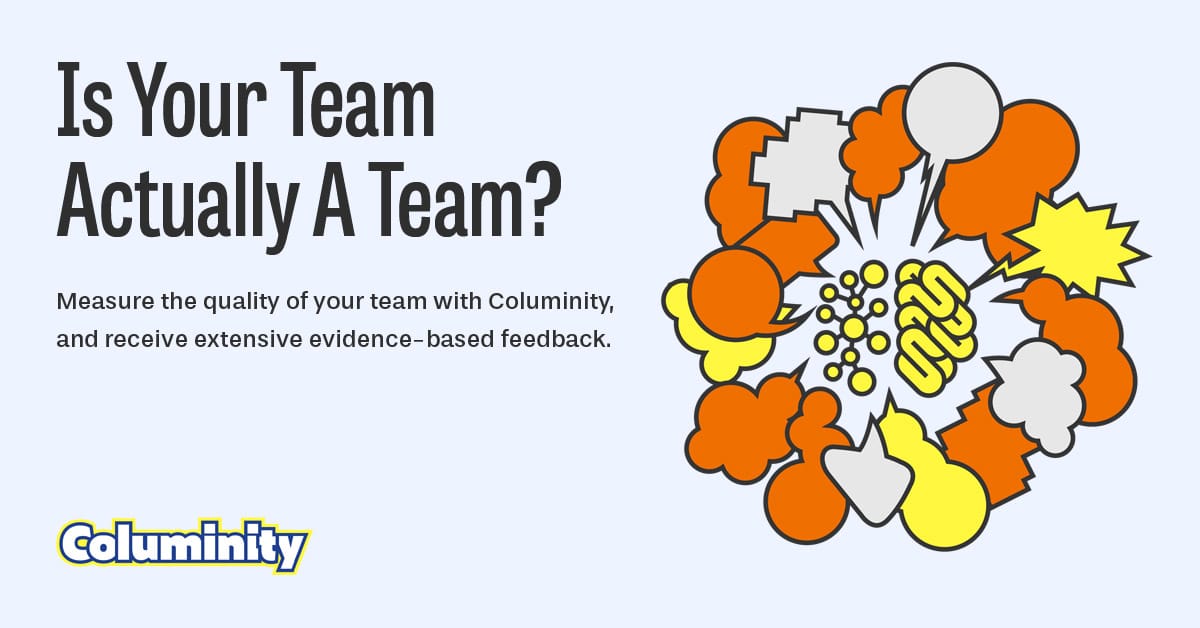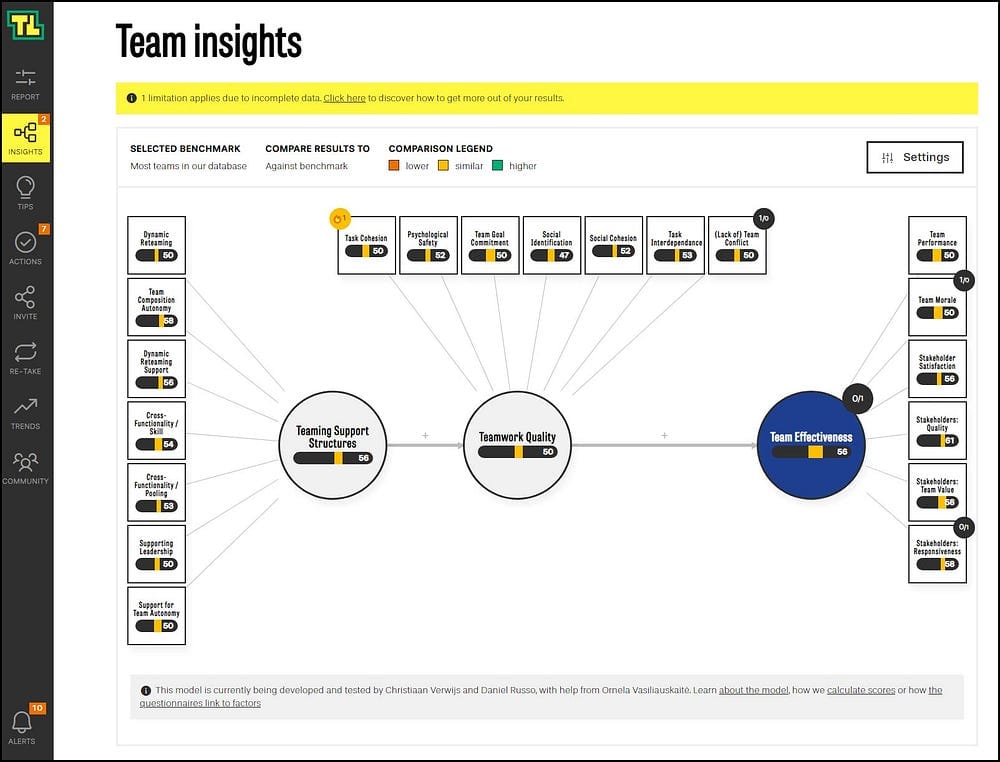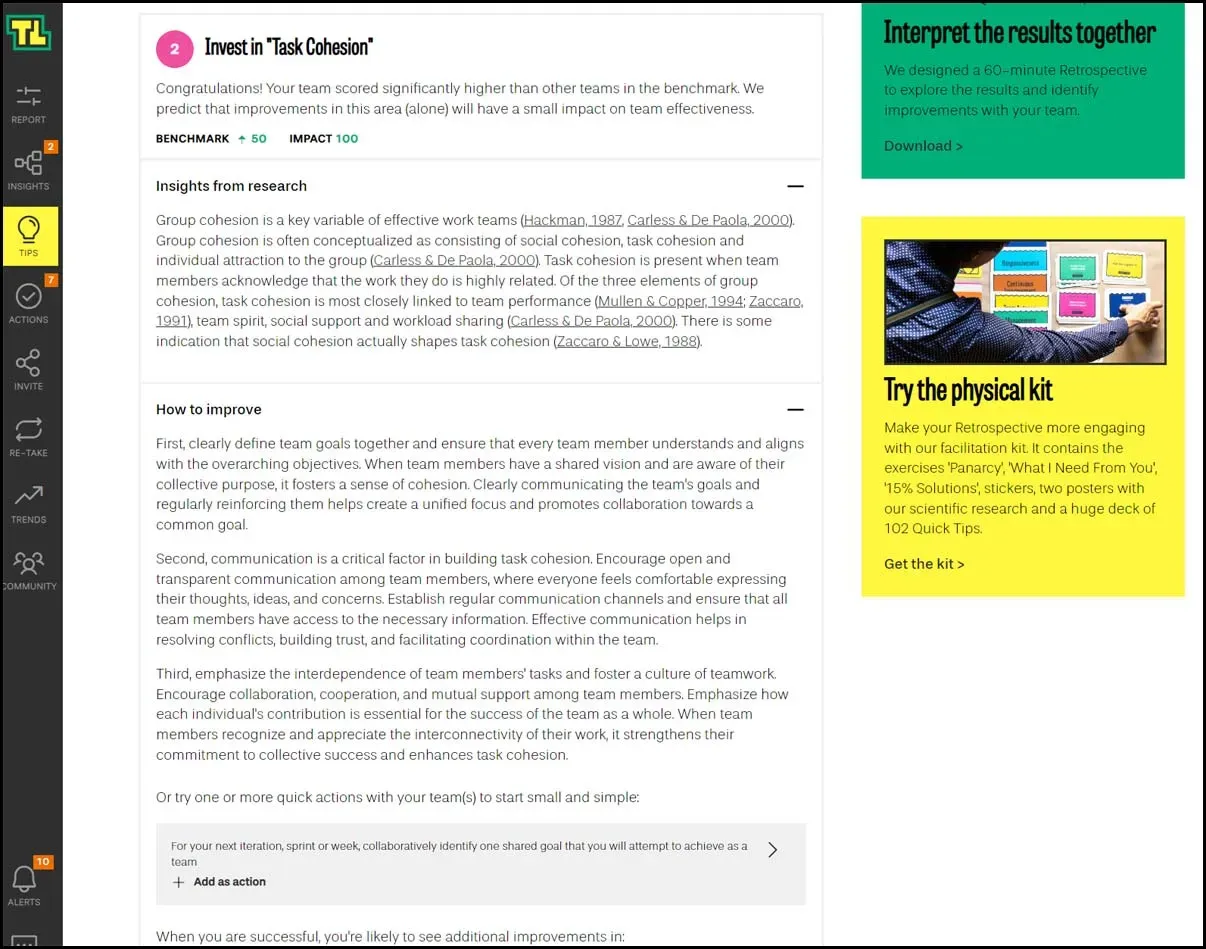Is Your Team Actually A Team?

"Teams don't work" is the pragmatic conclusion of Richard Hackman, one of the founders of modern-day team research. Based on his research, Hackman concludes that teams generally perform worse than groups of individuals. This conclusion is surprising, given that most modern-day organizations rely on teams and teamwork.
However, Hackman adds an essential caveat to his finding: organizations, particularly management, often misunderstand “teamwork” and fail to support it properly. If teamwork is adequately understood and supported by organizations, the cliches of teamwork tend to become true; "the sum is greater than the parts", "stronger together", "1+1=3", and so on.
This matches our observations from working with teams. Teams are generally created by putting people together and naming them "team" on the organization chart. However, more is needed to transform a group of individuals into a team. What makes people into a team remains elusive. Consequently, much of the value of high-quality teamwork is lost, and everyone is left frustrated.

So, what makes high-quality teamwork? And how is this influenced by how the team is composed? We have initiated a scientific research project with Daniel Russo, Ph.D., to investigate teamwork quality. More importantly, you can now diagnose teamwork quality for free at teamworkquality.columinity.com. In return for your time, you get a ton of actionable feedback and detailed results. And your anonymous, team-level data is helpful for our research. In this post, we share the details.
Our Teamwork Quality Model
Teams are “bounded social systems whose members are interdependent for a shared purpose, and who interact as a unit with other individuals and groups in achieving that purpose” (Hackman, in Tindale et. al., 1999). I use this definition because Hackman is one of the most prolific researchers of teamwork and has shaped much of the research in this area to date. However, Gladstein, 1984 and Sundstrom, De Meuse, & Futrell, 1990 offer similar definitions.
These definitions highlight two criteria: team members depend on each other to complete their work and collaborate towards shared goals/tasks. It’s also interesting to note the use of bounded. This means that it is clear to everyone who is on the team and who is not. Finally, Hackman defines teams as social systems.

From this, we developed a preliminary model to capture teamwork quality with several factors that are grounded in existing teamwork research:
Our model measures
To what extent do team members rely on others to complete their work (Campion, Medsker & Higgs, 1993)? Studies have shown that task interdependence promotes information sharing, collaboration, and mutual support among team members, leading to higher creativity, problem-solving, and overall team effectiveness. Gully et al. (1995) found that social identification encourages cohesion, improving team productivity. Ilgen et al. (2005) found that interdependence facilitated task integration and improved team decision-making processes, ultimately enhancing team performance.
2. Task Cohesion
Where task interdependence captures the factual dependency between, task cohesion captures to what extent members feel that their work depends on each other (Carless & De Paola, 2000). Task cohesion is linked to team performance (Mullen & Copper, 1994; Zaccaro, 1991), team spirit, social support, and workload sharing (Carless & De Paola, 2000). Evidence shows that teams with high social cohesion also exhibit higher task cohesion over time (Zaccaro & Lowe, 1988).
3. Social Cohesion And Social Identification
Social cohesion and individual attraction to the group are conceptually quite similar (Carless & De Paola, 2000). They reflect the social realities of a team. Do they identify with each other? Do they identify as members of that team? Do they like being part of the team? More simply put, it reflects to which extent the team fulfills the social needs of people, such as being recognized by others and being part of something greater. Hackman (1987) considers cohesion as the key variable of effective teamwork (this includes task cohesion).
We treat social cohesion and social identification as separate factors in the model because they are often treated as closely related but not identical in research. Our investigation will show if this distinction makes sense for our purpose.
4. Psychological Safety
Schein (1992) conceptualized psychological safety as a climate where people can focus on shared goals over self-protection. More recently, Edmondson (1999) defined it as “the shared belief that it is safe to take interpersonal risk’’. Examples of this are asking for help. But also to disagree with others or to admit that you don’t know something. Psychological safety has been demonstrated to influence learning behavior, decision quality, and performance (Edmondson & Lei, 2014). This has also been found in Agile teams, specifically (Dreesen et. al., 2021; Duhigg, 2016). Moe, Dingsoyr & Dyba (2010) conclude that without sufficient trust at the group level, “team members will expend time and energy protecting, checking, and inspecting each other as opposed to collaborating to provide value-added ideas’’. The ability to give and receive peer feedback is one of the core components of effective teamwork in Agile teams (Strode, Dingsoyr & Lindsjorn, 2022).
5. Team Goal Commitment
To what extent do the members of a team feel committed to their goals as a team? Without such commitment, members will feel less engaged to engage in teamwork. In its simplest form, goal commitment is defined as “one’s determination to reach a goal” (Locke & Latham, 1990). Locke & Latham (2002) report that “specific difficult goals have been shown to increase performance on well over 100 different tasks involving more than 40.000 participants in at least eight countries, working in a laboratory, simulation, and field settings”.
6. (Low) Relational Conflict
Although conflict is a natural part of working with others, research by DeDreu & Weingart (2003) shows that even low to moderate conflict in teams decreases productivity. This means that teams must learn how to navigate conflict effectively and prevent upward escalation.
Outcomes Of High-Quality Teamwork
We expect that high-quality teamwork results in measurably higher outcomes. Our model measures the satisfaction of stakeholders (directly by stakeholders or self-reported by teams), team morale, and team performance.
Predictors Of High-Quality Teamwork
Finally, we also measure several factors that contribute to high-quality teamwork or can impede it. This includes supporting leadership, cross-functionality, team autonomy, and support structures for (dynamic) teaming.
Get Evidence-Based Feedback
Go to teamworkquality.columinity.com to diagnose your team on teamwork quality. The questionnaire works for any team, Acomplete. You can participate with complete anonymity, and your results remain private. You can invite your entire team, its stakeholders, and even management. We combine the results to create a team report for your team. It contains detailed results. We also offer extensive evidence-based feedback to improve social cohesion, task cohesion, psychological safety, etc. This includes tips, concrete strategies, and quick actions to improve tomorrow.
You can also participate with more teams and aggregate their results in our Teams Dashboard.

Contribute to research
Our scientific investigation benefits you, your team, and your organization because we aim to develop practical recommendations and strategies based on empirical evidence to improve teamwork quality. We also want to investigate how (dynamic) teaming practices influence teamwork quality and what can be done to improve it.
To perform our investigation, we need data from at least 1.000 teams. We have also conducted qualitative interviews at several organizations to understand how they approach teamwork quality and how it is impacted by, e.g., teaming practices. Follow the progress on our Research page.
Closing Words
We hope to bring a new perspective on teamwork and more urgency in organizations to support it properly. Both with the scientific studies we are performing and the tool we are freely making available, you can already begin improving teamwork in your team. Enjoy!
Learn more at columinity.com. Or contact us at info@columinity.com.

